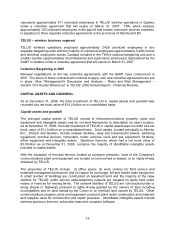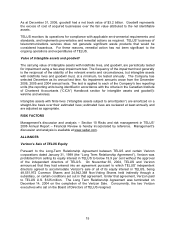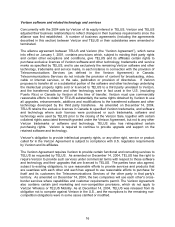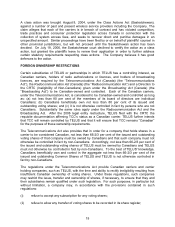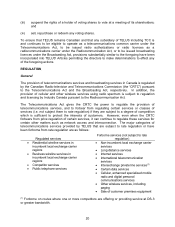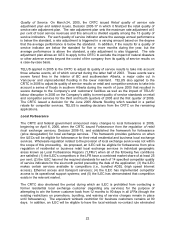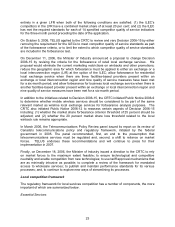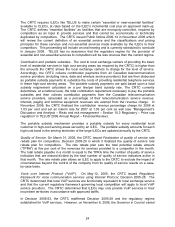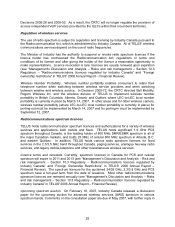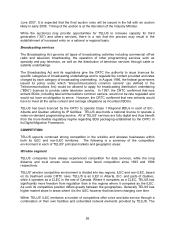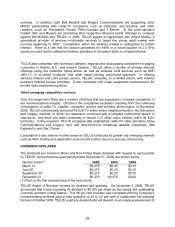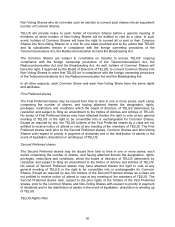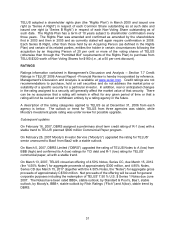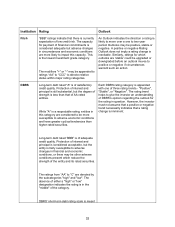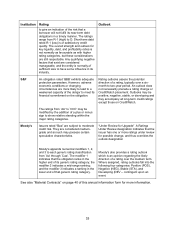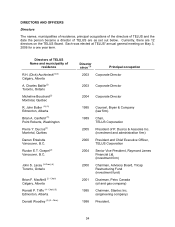Telus 2006 Annual Report Download - page 25
Download and view the complete annual report
Please find page 25 of the 2006 Telus annual report below. You can navigate through the pages in the report by either clicking on the pages listed below, or by using the keyword search tool below to find specific information within the annual report.The CRTC requires ILECs like TELUS to make certain “essential or near-essential facilities”
available to CLECs, at rates based on the ILEC’s incremental cost plus an approved mark-up.
The CRTC defines “essential facilities” as facilities that are monopoly-controlled, required by
competitors as an input to provide services and that cannot be economically or technically
duplicated by competitors. The CRTC issued Public Notice 2006-14 in November 2006 which
will review the current definition of an essential service and the classifications and pricing
principles for these services and non-essential services made available by the ILECs to their
competitors. This proceeding will include an oral hearing and is currently scheduled to conclude
in January 2008. TELUS has no assurance that the regulatory regime for the provision of
essential and non-essential services to competitors will be less onerous than the current regime.
Contribution and portable subsidies. The cost to local exchange carriers of providing the basic
level of residential services in high cost serving areas (as required by the CRTC) is higher than
the amounts the CRTC allows the local exchange carriers to charge for the level of service.
Accordingly, the CRTC collects contribution payments from all Canadian telecommunication
service providers (including voice, data and wireless service providers) that are then disbursed
as portable subsidy payments to subsidize the costs of providing residential telephone services
in these high-cost serving areas. The portable subsidy payments are paid based upon a total
subsidy requirement calculated on a per line/per band subsidy rate. The CRTC currently
determines, at a national level, the total contribution requirement necessary to pay the portable
subsidies and then collects contribution payments from the Canadian telecommunication
service providers, calculated as a percentage of their telecommunication service revenue.
Internet, paging and terminal equipment revenues are exempt from the revenue charge. In
November 2006, the CRTC finalized the contribution revenue percentage charge for 2006 at
1.03 per cent and set an interim rate for 2007 at 1.03 per cent as well (see “Management’s
Discussion and Analysis – Risks and risk management – Section 10.3 Regulatory – Price cap
regulation” in TELUS’ 2006 Annual Report – Financial Review).
The portable subsidy mechanism provides a portable subsidy for every residential local
customer in high-cost serving areas served by an ILEC. The portable subsidy amounts for each
high-cost band in the serving territories of the large ILECs are updated annually by the CRTC.
Quality of Service. On March 31, 2005, the CRTC issued Finalization of quality of service rate
rebate plan for competitors, Decision 2005-20 in which it finalized the quality of service rate
rebate plan for competitors. The rate rebate plan sets the total potential rebate amount
(“TPRA”) at five per cent of the revenues for services provided to a competitor in the month.
The total rebate payable in a month is equal to the TPRA time the number of quality of service
indicators that are missed divided by the total number of quality of service indicators active in
that month. The rate rebate plan allows an ILEC to apply to the CRTC to exclude the impact of
circumstances beyond the control of the company from its quality of service results on a case-
by-case basis.
Voice over Internet Protocol (“VoIP”). On May 12, 2005, the CRTC issued Regulatory
framework for voice communication services using Internet Protocol, Decision 2005-28. The
CRTC determined that local VoIP services are functionally equivalent to local exchange service
and that the current regulatory framework governing local competition will apply to local VoIP
service providers. The CRTC determined that ILECs may only provide VoIP services in their
incumbent territories in accordance with approved tariffs.
In Decision 2006-53, the CRTC reaffirmed Decision 2005-28 and the regulatory regime
established for VoIP services. However, on November 9, 2006, the Governor in Council varied
24


